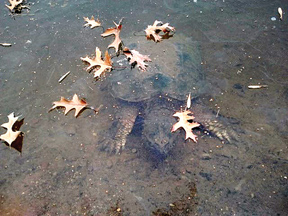Snapping turtles survive winter by burying themselves in mud at the bottom of ponds or lakes. They slow down their metabolism to conserve energy during the cold months.
Snapping turtles, known for their tough exteriors and powerful jaws, have developed unique adaptations to endure harsh winter conditions. As the temperatures drop, these turtles seek refuge by burying themselves in the mud at the bottom of bodies of water.
By slowing down their metabolism, they can conserve energy and survive without food for extended periods. This strategy allows snapping turtles to hibernate throughout the winter months until the warmer temperatures of spring arrive. Let’s explore in more detail how these fascinating creatures manage to thrive in challenging winter environments.

Credit: www.lakechamplaincommittee.org
Habitat Adaptations
Burrowing Behavior
Snapping turtles exhibit a unique burrowing behavior as part of their habitat adaptations to survive winter. When the temperature drops, these turtles dig into the soft mud at the bottom of bodies of water, such as ponds, lakes, or slow-moving streams. They create a small cavity, known as a hibernaculum, where they remain dormant until spring.
Reduced Metabolic Rate
Another crucial adaptation is the snapping turtle’s ability to reduce its metabolic rate during the winter months. This means that the turtle’s physiological processes, such as respiration and digestion, slow down significantly, allowing them to conserve energy and survive with minimal food intake.

Credit: www.wxpr.org
Physiological Changes
Physiological changes enable snapping turtles to survive the harsh winter months, allowing them to endure the cold temperatures and scarcity of food. These changes involve a range of cold-tolerance mechanisms and hibernation patterns that are vital for their winter survival.
Cold-tolerance Mechanisms
Snapping turtles possess remarkable adaptations that enable them to tolerate cold temperatures. These include the production of antifreeze proteins in their blood, which prevents ice crystals from forming and causing cellular damage. Additionally, they can slow down their metabolism to conserve energy and withstand prolonged periods of cold.
Hibernation Patterns
During winter, snapping turtles enter a state of brumation where their metabolic rate significantly decreases, allowing them to conserve energy. They seek out muddy bottoms of bodies of water, where they can burrow into the sediment and remain relatively insulated from the freezing temperatures above. This state of dormancy helps them survive until the arrival of warmer weather.
Food And Nutrition
Winter Diet
Snapping turtles adapt to winter by altering their diet.
Energy Reserves
They rely on stored fat and protein for sustenance.
Behavioral Strategies
Behavioral strategies play a crucial role in the survival of snapping turtles during the harsh winter months. These remarkable reptiles have developed specific behaviors to cope with the cold temperatures and scarcity of resources. Understanding their behavioral strategies sheds light on the fascinating adaptations that enable snapping turtles to endure the challenges of winter.
Seeking Warmth
Snapping turtles employ various tactics to seek warmth during winter. They often burrow into the mud at the bottom of bodies of water, where the temperature is relatively stable and above freezing. This behavior, known as brumation, allows them to conserve energy and maintain a more favorable body temperature. Additionally, snapping turtles may also bask in the sun when opportunities arise, absorbing heat to regulate their internal temperature.
Limited Activity
During winter, snapping turtles exhibit limited activity to conserve energy. They reduce their movements and metabolic rate, entering a state of dormancy to minimize energy expenditure. By slowing down their physiological processes, they can endure extended periods without food and maintain their vital functions at a reduced level. This behavioral adaptation enables snapping turtles to survive the scarcity of food sources during winter.
Predator Avoidance
When it comes to surviving winter, snapping turtles have evolved remarkable predator avoidance strategies. These ancient reptiles have developed various tactics to protect themselves from predators during the harsh winter months.
Choosing Safe Locations
Snapping turtles are adept at choosing safe locations for hibernation. They often burrow into the mud at the bottom of ponds, lakes, or slow-moving rivers, where they can remain hidden from potential predators. By selecting these secluded areas, snapping turtles minimize the risk of encountering predators during their vulnerable hibernation period.
Camouflage Techniques
Another important predator avoidance strategy employed by snapping turtles is their remarkable camouflage techniques. Their shells often blend seamlessly with the surrounding environment, providing them with effective protection from potential threats. This natural camouflage helps them remain undetected, reducing the risk of becoming prey during the winter months.
Human Impact
Human activities have a significant impact on the survival of snapping turtles during the winter months.
Conservation Efforts
Efforts are in place to protect snapping turtles from human-induced threats.
Threats To Survival
The survival of snapping turtles is threatened by human activities such as habitat destruction and pollution.

Credit: www.turtleskingston.com
Conclusion
Snapping turtles are well adapted to survive the harsh winter months. They bury themselves in the mud at the bottom of bodies of water, and their unique physiology allows them to slow their metabolism and survive for months without oxygen.
Additionally, they have a variety of behavioral adaptations that help them survive the cold, including regulating their body temperature and conserving energy. Understanding how these creatures survive can help us appreciate their resilience and adaptability in the face of challenging conditions.






Leave a Reply